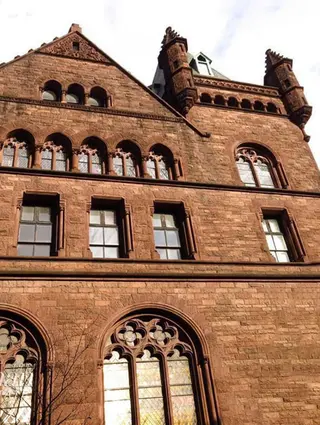 Carter Horsley
Carter HorsleyJun 18, 2015
Carter's Review
The rugged fantasy castle of Abbey Condominium at 205 East 16th Street between Third Avenue and Rutherford Place on the west side of Stuyvesant Park was originally the parish house of St. George’s Church next door.
It was erected in 1888 and designed by Charles Otto Blesch in Romanesque Revival style with interiors by Leopold Eidlitz.
It was acquired by Herbert W. Hirsch Enterprises Inc. in 1996 and converted to 31 condominium apartments in 2005.
Bottom Line
An impressive and handsome, mid-block brownstone confection that used to be the parish house of St. George’s Church fronting on the lovely fenced Stuyvesant Park that for many years was J. P. Morgan’s church is convenient to all the charms of Irving Place, Gramercy Park, the green market at Union Square and the colorful paraphernalia of Paragon Sports….
Description
The brown rock façades of the building have round-arched openings and gabled rooflines, finials and towers. The building has a large pyramid roof.
Amenities
The building has a full-time doorman, video security and a live-in superintendent. It is pet friendly.
Apartments
Each apartment has a different layout and a washer and dryer.
The garden apartment is a two-bedroom quadruplex with a living room, and an open kitchen on the first floor, a loft space on the mezzanine level, a 25-foot-long master bedroom on the second floor and another bedroom with outdoor space on the garden level.
Apartment 6E is a one-bedroom duplex with 20-foot-living/dining room with an open, pass-through, 9-foot-long kitchen and a spiral staircase to an 11-foot-long mezzanine.
Apartment 3F is a two-bedroom duplex unit with an entry into an 11-foot-wide dining room with an open kitchen that leads up one step to a 19-foot-wide, double-height living room that leads up two steps to a master bedroom. The second bedroom is on the mezzanine level.
Apartment 4A is a two-bedroom duplex with an 8-foot-long vestibule that leads to a 14-foot-wide dinette with an open 9-foot-wide kitchen and a 20-foot-wide, double-height living room.
History
Trinity Church established the Chapel of St. George’s on Beekman Street in Lower Manhattan in 1749. In 1822, it became a self-supporting parish of the Episcopal Church and in 1846 it moved to Stuyvesant Square, the same year that the ministry of the Calvary Church moved to Gramercy Park where Edith Wharton used it was the setting for her novel, “The Age of Innocence.” Calvary had been the church of the Roosevelt family. When it was built, the spires of St. George’s were visible from the East River
Meanwhile, the Church of the Holy Communion was erected in 1844 on Sixth Avenue and its founder, the Rev. William Muhlenberg, a leader of the evangelical Catholic movement within the Episcopal Church established a parish infirmary that became St. Luke’s Hospital and the parishioners’ Easter tradition of carrying flowers to the infirmary was the beginning what is now the Easter Parade.
The three congregations merged in 1975, when the Stuyvesant Square Historic District was created, but subsequently the Church of the Holy Communion was converted into the Limelight discotheque and then as an marketplace.
In 1883, the Rev. William Stephen Rainsford became the new rector of St. George’s, noting that “the aspect of the modern Protestant churches, in our large cities at least, is repellant to the poor man” and he set out to downplay doctrinal matters and abolish pew rentals as well as initial social services for the poor such as an industrial school, sewing classes, soup kitchens, health programs and the like and J. P. Morgan agreed to finance any deficits.
An April 13, 1894 article in The New York Times noted that the wedding at the church of Juliet Morgan, the second daughter of J. Pierpont Morgan, to William Pierson Hamilton was “unquestionably the most fashionable and beautiful of all the Spring weddings, and many other cities were represented,” adding that “over 3,000 invitations had been sent out….”
A June 30, 1957 article in The New York Times reported the marriage at the church of Miss Ann Phipps, the daughter of Mr. and Mrs. Howard Phipps of Westbury, L.I, and Delray Beach, Fla., and Constantine Sidamon-Eristoff, son of Prince and Princess Simon C. Sidamon-Eristoff of 514 East 89th Street and Highland Falls, N.Y., and great-grandson of John Bigelow, United States Minister to France and co-owner of The New York Evening Post.
The land for the building was given to the church for one dollar by J. P. Morgan, the banker and a senior warden of the church, which had twin towers until they were removed in 1889. The present parish house building that is now a residential condominium replaced a “barn-like” church hall on the site in 1888.
The parish house was a women’s residence in the 1960s.

- Condo built in 1888
- Converted in 2015
- Located in Gramercy Park
- 31 total apartments 31 total apartments
- 10 recent sales ($1.2M to $2.9M)
- Pets Allowed

 6sqft delivers the latest on real estate, architecture, and design, straight from New York City.
6sqft delivers the latest on real estate, architecture, and design, straight from New York City.
